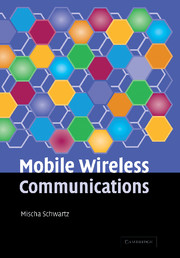Book contents
- Frontmatter
- Contents
- Preface
- 1 Introduction and overview
- 2 Characteristics of the mobile radio environment–propagation phenomena
- 3 Cellular concept and channel allocation
- 4 Dynamic channel allocation and power control
- 5 Modulation techniques
- 6 Multiple access techniques: FDMA, TDMA, CDMA; system capacity comparisons
- 7 Coding for error detection and correction
- 8 Second-generation, digital, wireless systems
- 9 Performance analysis: admission control and handoffs
- 10 2.5G/3G Mobile wireless systems: packet-switched data
- 11 Access and scheduling techniques in cellular systems
- 12 Wireless LANs and personal-area networks
- References
- Index
10 - 2.5G/3G Mobile wireless systems: packet-switched data
Published online by Cambridge University Press: 05 June 2012
- Frontmatter
- Contents
- Preface
- 1 Introduction and overview
- 2 Characteristics of the mobile radio environment–propagation phenomena
- 3 Cellular concept and channel allocation
- 4 Dynamic channel allocation and power control
- 5 Modulation techniques
- 6 Multiple access techniques: FDMA, TDMA, CDMA; system capacity comparisons
- 7 Coding for error detection and correction
- 8 Second-generation, digital, wireless systems
- 9 Performance analysis: admission control and handoffs
- 10 2.5G/3G Mobile wireless systems: packet-switched data
- 11 Access and scheduling techniques in cellular systems
- 12 Wireless LANs and personal-area networks
- References
- Index
Summary
Introduction
Previous chapters of this book have focused on second-generation (2G) wireless systems designed principally for wireless telephony, i.e., to carry voice calls, interfacing with wired telephone networks. We discuss in this chapter worldwide efforts to develop and deploy more advanced cellular networks, designed to provide higher bit rate wireless data services to interface with the Internet and other data networks. The objective is to provide wireless networks capable of carrying multimedia traffic such as voice, video, images, and data files interfacing with wired networks to present the user with seamless communication, where possible, end-to-end. These cellular networks extend the 2G systems into what is generally characterized as the third-generation (3G) or, for some cases, 2.5G systems. Much higher bit rate wireless local-area networks (W-LANs) have been designed as well to provide some of the same services, and are already beginning to pervade the business and academic sectors. These are discussed in Chapter 12. The new generation of cellular networks treats voice communication essentially the way the second generation does – as circuit-switched telephone traffic. Data, however, are to be carried in packet-switched format. The data bit rates used are higher than those currently available in the 2G systems. The wireless LANs (WLANs) discussed in Chapter 12 use packet switching exclusively. Studies are going on concurrently on fourth-generation cellular systems as well. Those systems would be expected to be all-packet-switched, interfacing seamlessly with packet-switched wired networks such as the Internet.
- Type
- Chapter
- Information
- Mobile Wireless Communications , pp. 307 - 360Publisher: Cambridge University PressPrint publication year: 2004



